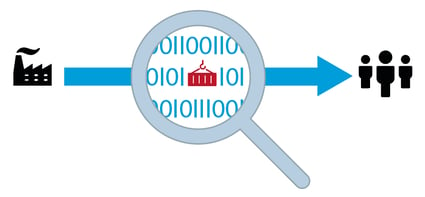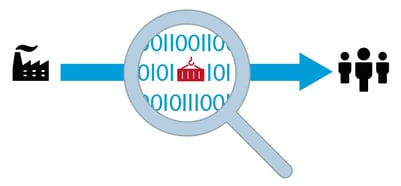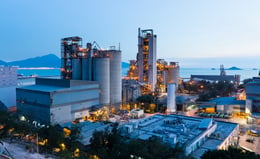How Advanced Analytics Will Impact Shippers
Brian Hoey - December 10, 2019

 They say that those who don’t learn from history are doomed to repeat it—but in point of fact, relying too heavily on historical knowledge can often be just as bad. History tells us a particular new innovation will never work, or a new strategy will never succeed, and as a result we’re often blindsided when something truly innovative or unusual comes around. This is particularly true in the logistics industry, where changes in the global economy and the nature of supply chain technology are causing an exponential increase in the number of paths that any given cargo might take from producer to consumer.
They say that those who don’t learn from history are doomed to repeat it—but in point of fact, relying too heavily on historical knowledge can often be just as bad. History tells us a particular new innovation will never work, or a new strategy will never succeed, and as a result we’re often blindsided when something truly innovative or unusual comes around. This is particularly true in the logistics industry, where changes in the global economy and the nature of supply chain technology are causing an exponential increase in the number of paths that any given cargo might take from producer to consumer.
This presents a challenge for shippers in particular, and a big part of the answer to that challenge will come in the form of new technology—in particular, advanced prescriptive and predictive analytics. With an increase in overall complexity of the logistics chain, many shippers suddenly find themselves in possession of more data than ever before, with swaths of information being collected by their APS systems, their customer-facing software integrations, and, increasingly, trucks and containers themselves. Rather than letting this data sit idle, logistics providers are finally beginning to use digital processes to extract value from them, and the result is a slow but powerful evolution in the shipping industry.
Network Optimization
Let’s pause a second for a little bit of background: advanced analytics (which can often be powered by things like AI and machine learning) is typically broken out into two categories: predictive and prescriptive analytics. The former focuses on improving forecasts for things like total shipping costs and demand levels, while the latter examines existing processes and networks to find areas of waste or inefficiency. This can include things like “what if” scenarios, in which supply chain planners test out potential changes or improvements on a digital version of their transport network. Given the increasing complexity of the average transport network, it’s not hard to see how this could add value. For instance, this type of prescriptive analytics process might help you to identify:
- Redundant hubs or warehouses in your network that could be removed in order to reduce costs;
- Potential areas for increased use of multi-modal shipping;
- Gaps in your data collection (i.e. smart containers that aren’t transmitting back to your core IT network or shipping partners that don’t integrate with your existing data infrastructure).
Using these kinds of analytics flows, you can begin to take a more systematic approach to orchestrating your transportation network—one that helps to reduce waste and minimize unnecessary modal changes, LTLs (less-than-full truckloads), etc. If, for instance, a client was trying to route some temperature-sensitive cargo through the Middle East, your prescriptive analytics could help you to ensure that each touchpoint on your value chain provided the optimal amount of connectivity (such that you could monitor the temperature of the freight in real-time to stave off spoilage), and then help you find the optimal organization of routes and tours to get the right product to the right place at the right time. This can enhance your ROI by keeping costs down—but in order to take full advantage you will need to prioritize the kind of connectivity we’re describing. It isn’t enough to simply gather data and let it languish in a data swamp; you need to be sure that it's being collected, stored, and managed in such a way as to empower analytics-based planning.
Supply Chain Risk Management
Just as prescriptive analytics can help you to reduce waste, predictive analytics can help you to mitigate supply chain disruptions—provided, again, that you’ve got sufficient data availability to let the analytics flows work their magic. Let’s say, for instance, that freight prices in a particular region are about to rise dramatically due to high demand: if you were making your supply chain decisions based solely on information collected from past shipping routes, you might easily be blindsided by this and ultimately have to eat the increased costs. If, by contrast, you were able to break out of the reactive planning cycle and move beyond mere descriptive and diagnostic analyses of historical events, you’d be more likely to see the price increase coming, meaning that you could secure your freight earlier and keep down costs.
Ultimately, this same logic can be applied beyond cost-optimization to things like order-fulfillment optimization, shipping time reduction, etc. How can you accomplish these otherwise difficult feats?
- Predictive workflows that use past traffic data to help you avoid risky routes;
- Real-time updates from your customers’ production plants to help you identify late shipments and adjust your loads, bundling, and routing accordingly;
- Instantaneous re-planning in the event of a weather event or other disruption, such that new routes can be adopted without any expensive lag time.
Anticipatory Logistics
Right now, any number of the challenges that shippers face—from changing customer demands to more complex routing possibilities—effectively require decision-makers in these companies to get faster and smarter with their data. This will help mitigate a lot of the sorts of disruptions that result from rigid planning and poor visibility—but that’s not the full extent of the endgame. In theory, the kinds of analytics we're talking about could one day soon begin to the power the world of anticipatory logistics. This would involve machine learning algorithms so sophisticated that they could predict customer orders before they come with a relatively high degree of accuracy—meaning that you could become even leaner and more efficient with the way you orchestrate your network,
While this is certainly a ways off, laying the groundwork begins with taking the right approach to today’s challenges. What does that look like, exactly? Essentially, it means that every time you make an operational change or adopt a new piece of technology, you need to make sure it’s going to improve data collection, reduce silos, and actually support human planners. This requires a healthy skepticism towards any sort of IT that’s difficult to integrate or doesn't play nicely with other technology. Ultimately, by keeping your goals for digital transformation in mind when making decisions, you can pave the way for a much more adaptable and profitable supply chain as we head into the era of Logistics 4.0.
LATEST POSTS
- Understand Why Production Planning Needs Specialized Solutions
- Understand Circular Economy in The Manufacturing Industry
- How Can Industry 4.0 IT Integration Be Achieved Smoothly?
- The Significance of Order Sequencing in Discrete Manufacturing
- How to improve your Supply Chain Management: The Power of Control Towers



